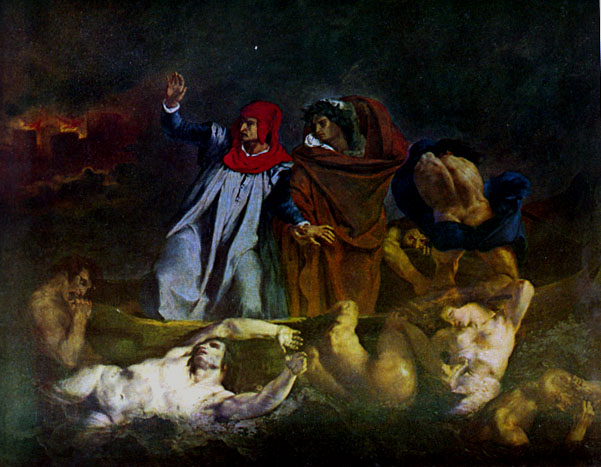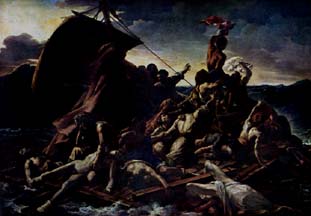Although the writer is free to choose between portraying the shipwreck and similar paradigms from inside — that is, from on board the vessel - or from a more distant vantage-point, the painter must depict this situation from without. Since narrative distance is itself a convention, or meaningful code, which the author uses to convey his judgments, the painter's portrayal of events from "outside" makes this code essentially unavailable to him. Although still photography and cinematography have presented air, ship, train, and automobile disasters from within the situation, painterly representations have not. Géricault, for instance, does not portray the raft of the Medusa from within the confines of that perilous assemblage of planks, for to create such a representation would be to produce the image as seen by those on the raft and not the image of those on the raft themselves. Painting, in other words, is condemned to take such an external view; or rather one should state that painting in a realistic style must adopt such a vantage-point, since, as Boris Uspensky has shown ancient and medieval art occasionally adopted an interior point of view.
In "Structural Isomorphism of Verbal and Visual Art," the Russian semiotician claims that 'some of the most ancient pictorial forms . . . definitely point to the internal position of the artist', and he offers as examples Assyrian landscape reliefs dating from the eighth century B.C. in which the hills and trees on both sides of the river are pictured as if they lay flat. On the one side of the river the tops of the hills and trees point upwards, while on the other side they are directed downwards.
Similarly, in various parts of the ancient world the usual representation [193/194] of a fortress depicts the towers lying flat and pointing from the center to the periphery of the picture, upwards, downwards and sidewards. It is clear that this picture could only be made when the artist mentally located himself in the center of the space represented. (Poetics 5 [1971-2]: 12).
According to Uspensky, a second example of this artistic phenomenon appears in medieval art, in which an internal light source in the picture's center casts a shadow in the foreground, since this "internal light corresponds to the internal position of the observer (artist) inside the picture" (p. 12). A third evidence of interior vantage-point in visual arts appears in perspectival modes:
The classical linear perspective presents the image as it is perceived externally (from the outside, i.e. From a fixed point of view-EXTERNAL as regards the reality to be represented). . . . On the other hand, the so-called inverse perspective (die umgekehrte Perspektive) characteristic of ancient and medieval art is based on not an external, but an internal position of the artist. A typical feature of the inverse perspective is the reduction in the size of the objects represented which does not correspond to their remoteness from the spectator (as in linear perspective), but, on the contrary, to their nearness to him, i.e., the figures in the background arc larger than those in the foreground. The phenomenon may be interpreted in such a way that in this system the reduction in sizes is not presented from OUR point of view (i.e., from the point of view of the observer who assumes an external position as regards the picture), but from the point of view of our vis-à-vis an abstract internal observer who is thought to be located in the interior of the picture. [pp. 12-13]
Uspensky's discussions of internal perspectives, positioning and light sources demonstrate that such are not only possible in the visual arts but entirely dominated them for hundreds and even thousands of years. Realistic styles of painting, however, do not permit the use of such techniques of internalization.
Even though the nineteenth-century painter in a realistic style could not, like the contemporary poet, move into the situation of the disaster, he could move closer to the event, thus making it dominate his image and endowing it with immediacy. This use of a vantage point close to the victims appears, for instance, in Joseph Franque's [194/195] Scene During the Eruption of Vesuvius (c. 1827, Philadelphia Museum of Art) in which the four victims entirely fill the canvas. Géricault, who gradually evolved his conception of The Raft of the 'Medusa', chose much the same method of implicating the spectator in the situation of crisis. As Eitner has pointed out, the artist first placed the raft farther away from the spectator and facing him. He then
re-oriented the figures on the Raft, turning them away from the spectator toward a point in the depth of the picture. At the same time, he moved the Raft so close to the foreground as to make the viewer feel transported onto its planks and to involve him in its drama as a participant rather than a detached observer.1
 Géricault's influence made such close-up views of imperiled mariners and the ship in danger popular in Romantic painting. For example, Delacroix, who paints few explicit shipwrecks, employs such a vantage-point in Dante and Virgil (1822, Louvre), Christ on the Sea of Galilee (1854, Walters Art Gallery, Baltimore), and The Shipwreck of Don Juan (1840, Louvre), and one encounters it in the works of Ryder, Homer, Stanfield, Turner, and many others.
Géricault's influence made such close-up views of imperiled mariners and the ship in danger popular in Romantic painting. For example, Delacroix, who paints few explicit shipwrecks, employs such a vantage-point in Dante and Virgil (1822, Louvre), Christ on the Sea of Galilee (1854, Walters Art Gallery, Baltimore), and The Shipwreck of Don Juan (1840, Louvre), and one encounters it in the works of Ryder, Homer, Stanfield, Turner, and many others.
Géricault, however, did not rely solely upon a close vantage-point to encourage the spectator's empathy with the endangered victims of sea disaster. In an intermediate version of the picture, which Eitner calls Hailing an Approaching Rowing-boat, he first made the decisive changes of employing a close vantage-point and also opposing the position of the nearby victims to the distant one of their rescuers. As Eitner has shown, 'The effect of the scene now hinges on the juxtaposition of near and far elements' (26). The closeness of the raft leads the spectator to identify with those on board, and his eye is led by their actions to the small boat approaching. Géricault intensified this crucial juxtaposition in the final version, in which the men on the raft experience, not hope, but disappointment:
His final enlargement of the figures was intended not only to give them the impressiveness - or 'sublimity', to use Delacroix's word which a superhuman scale can confer, it was also to serve an expressive function essential to the meaning of the picture. Without representing the vastness of the ocean directly, Géricault sought to dramatize the isolation of the men on the Raft and the strain of their effort, by withdrawing beyond hope the rescue, toward which they [195/196] defiantly strive. He activated the distance, making it appear as a plunging recession, rather than a horizontal expanse, and intensified the illusion or space by means of radical foreshortenings. The enormous foreground figures push the horizon back; the few inches of canvas which separate the signaling men from the speck which signifies the Argus demand to be read as miles. It was clearly Géricault's purpose to draw the beholder into a close, empathetic participation with the action of his picture, and to make him feel the drama of the scene with his muscles as much as with his eyes.
The absence of a divinity who watches over the victims of shipwreck appears with particular clarity in Géricault's Raft of the 'Medusa' because, as Eitner suggests, the artist violated certain codes and expectations of the audience. First, the artist broke radically with contemporary art when he created a major public image without traditional religious or political meanings — something especially blatant because he chose a large canvas of the size previously reserved for statements of political and religious belief. Second, Gericault omitted any sort of secular or heavenly divinity, which were conventionally included in such works. The painters of the Napoleonic era, particularly Gros, had glorified the emperor by making scenes of human suffering the setting for imperial pomp.
According to Eitner,
Gros made this subordination of human suffering to a higher, political interest naively clear in the horizontal subdivision of his canvases: above the victims of war agonizing in the lower foreground, the Emperor and his retinue pass like a celestial vlsion .
Géricault omitted from thc Raft all devices fcr placing human suffering in an ideological context.
Its drama has no heros and no message. No God, saint, or monarch presides over the disaster; no common cause is in evidence; no faith, no victory justifies the suffering of the men on the Raft: their martyrdom is one without palm or flag. It is as if Géricault had taken the foreground of human misery from one of the Gros' pictures and omitted the apotheosis above. [p. 51]
The artist, in other words, makes his point by violating two codes or conventions, the first that large works were reserved for statements of ideological import sanctioned by church or state, and the second that such works which represented human suffering should contain an ideological justification of them. By omitting both expected features, Géricault forcefully created an image of human isolation and helplessness which proclaims the absence of such usual explanations.
Last modified 15 July 2007

